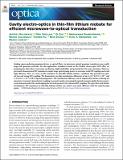Cavity electro-optics in thin-film lithium niobate for efficient microwave-to-optical transduction
Author(s)
Holzgrafe, Jeffrey; Sinclair, Neil; Zhu, Di; Shams-Ansari, Amirhassan; Colangelo, Marco; Hu, Yaowen; Zhang, Mian; Berggren, Karl K; Lončar, Marko; ... Show more Show less
DownloadPublished version (8.976Mb)
Publisher Policy
Publisher Policy
Article is made available in accordance with the publisher's policy and may be subject to US copyright law. Please refer to the publisher's site for terms of use.
Terms of use
Metadata
Show full item recordAbstract
© 2020 Optical Society of America. Linking superconducting quantum devices to optical fibers via microwave-optical quantum transducers may enable large-scale quantum networks. For this application, transducers based on the Pockels electro-optic (EO) effect are promising for their direct conversion mechanism, high bandwidth, and potential for low-noise operation. However, previously demonstrated EO transducers require large optical pump power to overcome weak EO coupling and reach high efficiency. Here, we create an EO transducer in thin-film lithium niobate, a platform that provides low optical loss and strong EO coupling. We demonstrate on-chip transduction efficiencies of up to (2.7 ± 0.3) × 10−5 and (1.9 ± 0.4) × 10−6/µW of optical pump power. The transduction efficiency can be improved by further reducing the microwave resonator’s piezoelectric coupling to acoustic modes, increasing the optical resonator quality factor to previously demonstrated levels, and changing the electrode geometry for enhanced EO coupling. We expect that with further development, EO transducers in thin-film lithium niobate can achieve near-unity efficiency with low optical pump power.
Date issued
2020Department
Massachusetts Institute of Technology. Research Laboratory of ElectronicsJournal
Optica
Publisher
The Optical Society
Citation
Holzgrafe, Jeffrey, Sinclair, Neil, Zhu, Di, Shams-Ansari, Amirhassan, Colangelo, Marco et al. 2020. "Cavity electro-optics in thin-film lithium niobate for efficient microwave-to-optical transduction." Optica, 7 (12).
Version: Final published version